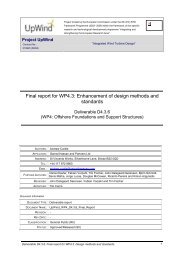Create successful ePaper yourself
Turn your PDF publications into a flip-book with our unique Google optimized e-Paper software.
UPWIND<br />
6. Load mitigation concept analysis at dynamic control<br />
level<br />
In the following Chapter, several concepts for load mitigation in the dynamic control level are<br />
introduced. These concepts use additional control loops and systems in order to reduce overall<br />
loading. The shown concepts just give an overview of possible options and could be extended.<br />
6.1 Tower-feedback control<br />
Aerodynamic damping is the main damping effect for modern wind turbines during operation.<br />
Both, aerodynamic and hydrodynamic loads are mitigated by this damping source mainly for<br />
flapwise blade and the nacelle fore-aft motion. Due to the major impact of the aerodynamic<br />
damping effect and since the effect is mainly caused by the aerodynamic conditions at the rotor<br />
blades and the tower top response of the support structure, active enhancement through the<br />
manipulation of the aerodynamic conditions via pitch control seems to be a powerful approach<br />
for the load mitigation. A possible approach to enhance this damping effect is the so-called<br />
tower-feedback control (TFC) concept.<br />
Figure 6.1: Principle of tower-feedback control<br />
The strategy is based on an estimation of the RNA movement in terms of velocities. Both, the<br />
instantaneous velocity and an approximation of the change in the velocity within a short period<br />
of time can be derived from the acceleration by integration. The additional pitch angle denotes<br />
the pitch angle that is superimposed to the pitch angle provided by the regular controller. The<br />
required direction of the additional pitch angle depends on the direction of the RNA velocity. If<br />
the RNA has the same direction as the wind an increase of the pitch angle compared to the<br />
regular pitch angle as demanded by the regular controller is required. For the opposite direction<br />
of the RNA movement i.e. against the wind direction an increased thrust force is induced by an<br />
additional decrease of the pitch angle. In both cases an additional thrust force component,<br />
compared to the regular case without extra pitch, is induced, acting against the direction of the<br />
RNA movement. The additional pitch angle must change the sign as soon as the RNA<br />
movement changes the sign. An ideal correlation of the additional pitch angle and the RNA<br />
Page 69 of 146











